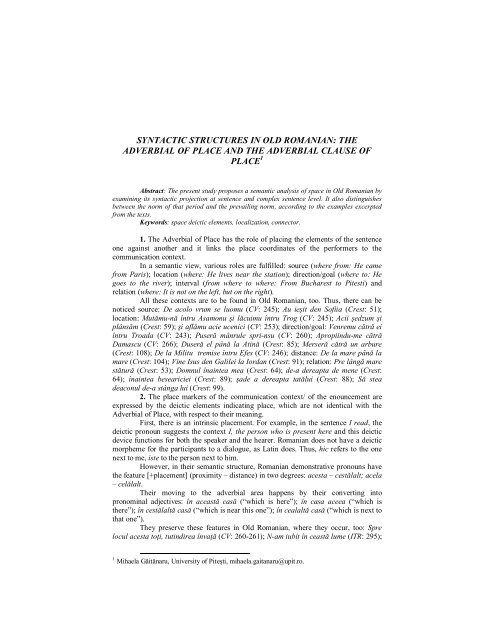language and literature european landmarks of identity
language and literature european landmarks of identity
language and literature european landmarks of identity
Create successful ePaper yourself
Turn your PDF publications into a flip-book with our unique Google optimized e-Paper software.
SYNTACTIC STRUCTURES IN OLD ROMANIAN: THE<br />
ADVERBIAL OF PLACE AND THE ADVERBIAL CLAUSE OF<br />
PLACE 1<br />
Abstract: The present study proposes a semantic analysis <strong>of</strong> space in Old Romanian by<br />
examining its syntactic projection at sentence <strong>and</strong> complex sentence level. It also distinguishes<br />
between the norm <strong>of</strong> that period <strong>and</strong> the prevailing norm, according to the examples excerpted<br />
from the texts.<br />
Keywords: space deictic elements, localization, connector.<br />
1. The Adverbial <strong>of</strong> Place has the role <strong>of</strong> placing the elements <strong>of</strong> the sentence<br />
one against another <strong>and</strong> it links the place coordinates <strong>of</strong> the performers to the<br />
communication context.<br />
In a semantic view, various roles are fulfilled: source (where from: He came<br />
from Paris); location (where: He lives near the station); direction/goal (where to: He<br />
goes to the river); interval (from where to where: From Bucharest to Pitesti) <strong>and</strong><br />
relation (where: It is not on the left, but on the right).<br />
All these contexts are to be found in Old Romanian, too. Thus, there can be<br />
noticed source: De acolo vrum se luomu (CV: 245); Au ieşit den S<strong>of</strong>iia (Crest: 51);<br />
location: Mutămu-nă întru Asamonu şi lăcuimu întru Trog (CV: 245); Acii şedzum şi<br />
plânsăm (Crest: 59); şi aflămu acie ucenici (CV: 253); direction/goal: Venremu cătră ei<br />
întru Troada (CV: 243); Puseră mânrule spri-nsu (CV: 260); Apropiindu-me cătră<br />
Damascu (CV: 266); Duseră el până la Atină (Crest: 85); Merseră cătră un arbure<br />
(Crest: 108); De la Militu tremise întru Efes (CV: 246); distance: De la mare până la<br />
mare (Crest: 104); Vine Isus den Galilei la Iordan (Crest: 91); relation: Pre lângă mare<br />
stătură (Crest: 53); Domnul înaintea mea (Crest: 64); de-a dereapta de mene (Crest:<br />
64); înaintea beseariciei (Crest: 89); şade a dereapta tatălui (Crest: 88); Să stea<br />
deaconul de-a stânga lui (Crest: 99).<br />
2. The place markers <strong>of</strong> the communication context/ <strong>of</strong> the enouncement are<br />
expressed by the deictic elements indicating place, which are not identical with the<br />
Adverbial <strong>of</strong> Place, with respect to their meaning.<br />
First, there is an intrinsic placement. For example, in the sentence I read, the<br />
deictic pronoun suggests the context I, the person who is present here <strong>and</strong> this deictic<br />
device functions for both the speaker <strong>and</strong> the hearer. Romanian does not have a deictic<br />
morpheme for the participants to a dialogue, as Latin does. Thus, hic refers to the one<br />
next to me, iste to the person next to him.<br />
However, in their semantic structure, Romanian demonstrative pronouns have<br />
the feature [+placement] (proximity – distance) in two degrees: acesta – cestălalt; acela<br />
– celălalt.<br />
Their moving to the adverbial area happens by their converting into<br />
pronominal adjectives: în această casă (“which is here”); în casa aceea (“which is<br />
there”); în cestălaltă casă (“which is near this one”); în cealaltă casă (“which is next to<br />
that one”).<br />
They preserve these features in Old Romanian, where they occur, too: Spre<br />
locul acesta toţi, tutindirea învaţă (CV: 260-261); N-am iubit în ceastă lume (ITR: 295);<br />
1 Mihaela Găitănaru, University <strong>of</strong> Piteşti, mihaela.gaitanaru@upit.ro.


